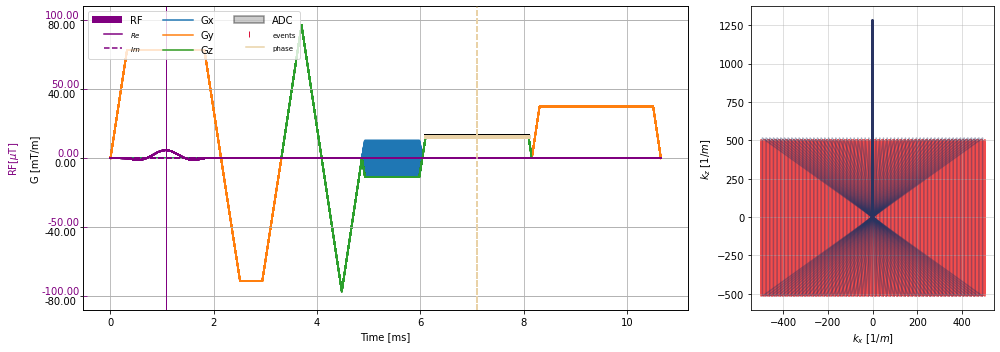Velocity encoded spoiled GRE with laminar flow (sequential)#
Imports#
[2]:
# Load TF and check for GPUs
import tensorflow as tf
physical_devices = tf.config.list_physical_devices('GPU')
if physical_devices:
print("Available GPUS: \n\t", "\n\t".join([str(_) for _ in physical_devices]))
tf.config.experimental.set_visible_devices(physical_devices[0], 'GPU')
tf.config.experimental.set_memory_growth(physical_devices[0], True)
from copy import deepcopy
# 3rd Party dependencies
import cmrseq
from tqdm.notebook import tqdm
from pint import Quantity
import pyvista
import numpy as np
import matplotlib.pyplot as plt
%matplotlib inline
# Project library cmrsim
import sys
sys.path.append("../..")
import cmrsim
from cmrsim.utils import particle_properties as part_factory
Available GPUS:
PhysicalDevice(name='/physical_device:GPU:0', device_type='GPU')
---------------------------------------------------------------------------
ModuleNotFoundError Traceback (most recent call last)
Cell In[2], line 12
9 from copy import deepcopy
11 # 3rd Party dependencies
---> 12 import cmrseq
13 from tqdm.notebook import tqdm
14 from pint import Quantity
ModuleNotFoundError: No module named 'cmrseq'
Define Velocity encoded Spoiled GRE#
Configure Sequence parameters#
[ ]:
# Define MR-system specifications
system_specs = cmrseq.SystemSpec(max_grad=Quantity(80, "mT/m"), max_slew=Quantity(200., "mT/m/ms"),
grad_raster_time=Quantity(0.01, "ms"),
rf_raster_time=Quantity(0.01, "ms"),
adc_raster_time=Quantity(0.01, "ms"))
# Define Fourier-Encoding parameters
fov = Quantity([301, 61], "mm")
matrix_size = (301, 61)
res = fov / matrix_size
print("Resolution:", res)
slice_position = Quantity([0., 0., 0.], "m")
pulse_duration = Quantity(1.5, "ms")
adc_duration = Quantity(2, "ms")
flip_angle = Quantity(np.pi/6, "rad")
n_dummy = 0
readout_direction = np.array([0., 0., 1.])
slice_normal = np.array([0., 1., 0])
slice_normal = slice_normal / np.linalg.norm(slice_normal)
slice_position = Quantity([0, 0, 0], "cm")
slice_position_offset=Quantity(np.dot(slice_normal, slice_position.m_as("m")), "m")
slice_thickness = Quantity(1, "mm")
time_bandwidth_product = 4
# Define Reseeding slice parameters
seeding_slice_position = Quantity([0.0, 0.0, 0.081], "m")
seeding_slice_normal = np.array([0., 1., 0.])
seeding_slice_thickness = Quantity(15, "mm")
seeding_pixel_spacing = np.array((0.5e-3, 0.5e-3, 0.5e-3)) # resolution of seeding mesh, mm
seeding_slice_bb = Quantity([4, 4, 6], "cm")
seeding_particle_density = 16 # per 1/mm*3
lookup_map_spacing = np.array((0.5e-3, 0.5e-3, 0.5e-3)) # resolution of seeding mesh, mm
# Velocity encoding settings:
venc_max = Quantity(0.5, "m/s")
venc_direction = np.array([1., 0., 0.]) # in mps
venc_duration = Quantity(0, 'ms') # Duration = 0 will result in shortest possible venc
Instantiate Sequence in MPS and insert VENC#
[3]:
sequence_list = cmrseq.seqdefs.sequences.flash(system_specs,
slice_thickness=slice_thickness,
flip_angle=flip_angle,
pulse_duration=pulse_duration,
time_bandwidth_product=time_bandwidth_product,
matrix_size=matrix_size,
inplane_resolution=res,
adc_duration=adc_duration,
echo_time=Quantity(1., "ms"),
repetition_time=Quantity(16., "ms"),
slice_position_offset=slice_position_offset)
crusher_area = Quantity(np.pi * 6, "rad") / system_specs.gamma_rad / res[0]
for idx, seq in enumerate(sequence_list):
rf_sequence = cmrseq.utils.get_partial_sequence(seq, seq.blocks[0:3], copy=False)
_, _, venc_seq = cmrseq.seqdefs.velocity.bipolar(system_specs, venc=venc_max.to("m/s"),
direction=venc_direction, duration=venc_duration)
ro_sequence = cmrseq.utils.get_partial_sequence(seq, seq.blocks[3:-1], copy=False)
ro_sequence.shift_in_time(-rf_sequence.get_block("slice_select_0").duration)
crusher = cmrseq.bausteine.TrapezoidalGradient.from_dur_area(system_specs, orientation=np.array([0., 0., 1.]),
duration=Quantity(2.5, "ms"), area=crusher_area.to("mT/m*ms"))
ro_sequence.append(crusher)
venc_seq.append(ro_sequence)
rf_sequence.append(venc_seq)
sequence_list[idx] = rf_sequence
/scratch/jweine/conda/envs/tf29_pyvista/lib/python3.9/site-packages/pint/quantity.py:1313: RuntimeWarning: invalid value encountered in double_scalars
magnitude = magnitude_op(new_self._magnitude, other._magnitude)
/scratch/jweine/conda/envs/tf29_pyvista/lib/python3.9/site-packages/cmrseq/parametric_definitions/sequences/_gradient_echo.py:76: UserWarning: Echo time too short to be feasible, set TE to 4.3100000000000005 millisecond
warn(f"Echo time too short to be feasible, set TE to {minimal_te}")
Rotate gradients to XYZ and plot#
[4]:
rot_matrix = cmrseq.utils.get_rotation_matrix(slice_normal, readout_direction, target_orientation='xyz')
for seq in sequence_list:
seq.rotate_gradients(rot_matrix)
_, k_adc, t_adc = sequence_list[0].calculate_kspace()
plt.close("all")
f, (a1, a2) = plt.subplots(1, 2, figsize=(14, 5), gridspec_kw={'width_ratios': [5, 2]})
cmrseq.plotting.plot_sequence(sequence_list[0], axes=a1, adc_yoffset=15.7)
for s in sequence_list[1:]:
cmrseq.plotting.plot_sequence(s, axes=[f.axes[-1], a1, a1, a1], format_axes=False, adc_yoffset=15.7)
for s in sequence_list:
cmrseq.plotting.plot_kspace_2d(s, ax=a2, k_axes=[0, 2])
f.tight_layout()

Set up Phantom#
Load mesh#
[5]:
# Load Aorta Example.
mesh = pyvista.read("../example_resources/steady_stenosis.vtk")
# The velocity [m/s] is stored in the mesh as U1. In cmrsim all definitions are done in [ms] therefore
# We add the velocity field as scaled data to the mesh
mesh["velocity"] = Quantity(mesh["U"], "m/s").m_as("m/ms")
# To match the usual geometry (Head <-> Foot along z-axis) flip the axes of the mesh
mesh.points = mesh.points[:,[2,1,0]]
mesh.points[:, 1:] *= -1
mesh["velocity"] = mesh["velocity"][:,[2,1,0]]
mesh["velocity"][:, 1:] *= -1
global_mesh_offset = [0.0, 0.0, 0.1]
mesh.translate(global_mesh_offset, inplace=True)
mesh = mesh.cell_data_to_point_data()
# clip to restricted length to reduce mesh-size
mesh.clip(normal='z', origin=[0., 0., 0.11], inplace=True)
mesh.clip(normal='-z', origin=[0., 0., -0.10], inplace=True)
[5]:
| Header | Data Arrays | ||||||||||||||||||||||||||||||||
|---|---|---|---|---|---|---|---|---|---|---|---|---|---|---|---|---|---|---|---|---|---|---|---|---|---|---|---|---|---|---|---|---|---|
|
|
Instantiate Refilling dataset#
[6]:
# Setup flow dataset with seeding mesh information
particle_creation_fncs = {"magnetization": part_factory.norm_magnetization(),
"T1": part_factory.uniform(default_value=250.),
"T2": part_factory.uniform(default_value=50.),
"M0": part_factory.uniform(default_value=1/seeding_particle_density)}
dataset = cmrsim.datasets.RefillingFlowDataset(mesh,
particle_creation_callables=particle_creation_fncs,
slice_position=seeding_slice_position.m_as("m"),
slice_normal=seeding_slice_normal,
slice_thickness=seeding_slice_thickness.m_as("m"),
slice_bounding_box=seeding_slice_bb.m_as("m"),
seeding_vol_spacing=seeding_pixel_spacing,
lookup_map_spacing=lookup_map_spacing,
field_list=[("velocity", 3)])
lookup_table_3d, map_dimensions = dataset.get_lookup_table()
trajectory_module = cmrsim.datasets.FlowTrajectory(velocity_field=lookup_table_3d.astype(np.float32),
map_dimensions=map_dimensions.astype(np.float32),
additional_dimension_mapping=dataset.field_list[1:],
device='GPU')
Updated Mesh
Updated Slice Position
Visualize#
Legend: - Red box: Slice selective excitation - White Plane: Imaging plane - Orange Box: Re-seeding volume
[7]:
pyvista.close_all()
pyvista.set_jupyter_backend('panel')
pyvista.start_xvfb()
plotter = pyvista.Plotter(notebook=True, window_size=(1000, 500), shape=(1, 2))
# Plot axes at origin
origin_arrows = [pyvista.Arrow(start=(0., 0., 0.), direction=direction, tip_length=0.1, tip_radius=0.025,
tip_resolution=10, shaft_radius=0.005, shaft_resolution=10, scale=0.1)
for direction in [(1., 0., 0.), (0., 1., 0.), (0., 0., 1.)]]
plotter.add_mesh(origin_arrows[0], color="blue", label="x")
plotter.add_mesh(origin_arrows[1], color="green", label="y")
plotter.add_mesh(origin_arrows[2], color="red", label="z")
# Plot input mesh
plotter.add_mesh(mesh, scalars="velocity", opacity=0.6, colormap="seismic")
# Plot slice selective RF
_scale = 0.1
rf_mesh = pyvista.Box(bounds=(-_scale, _scale, -_scale, _scale, -slice_thickness.m_as("m")/2, slice_thickness.m_as("m")/2))
rf_mesh.points = cmrseq.utils.mps_to_xyz(rf_mesh.points[np.newaxis], slice_normal=slice_normal, readout_direction=np.array([1., 0., 0.]))[0]
rf_mesh.translate(slice_position, inplace=True)
plotter.add_mesh(rf_mesh, opacity=0.1, show_edges=True, color="red")
# Plot projection plane of the cartesian image slice with M-S directions
image_slice_mesh = pyvista.Box(bounds=(-fov[0].m_as("m")/2, fov[0].m_as("m")/2, -fov[1].m_as("m")/2, fov[1].m_as("m")/2, 0, 0))
image_slice_mesh.points = cmrseq.utils.xyz_to_mps(image_slice_mesh.points[np.newaxis], slice_normal=slice_normal, readout_direction=readout_direction)[0]
readout_glyph = pyvista.Arrow(start=slice_position.m_as("m"), direction=readout_direction, tip_length=0.1, tip_radius=0.025,
tip_resolution=10, shaft_radius=0.01, shaft_resolution=10, scale=0.05)
slice_selection_glyph = pyvista.Arrow(start=slice_position.m_as("m"), direction=slice_normal, tip_length=0.1, tip_radius=0.025,
tip_resolution=10, shaft_radius=0.01, shaft_resolution=10, scale=0.05)
plotter.add_mesh(image_slice_mesh, opacity=0.3, show_edges=True)
plotter.add_mesh(readout_glyph, color="black")
plotter.add_mesh(slice_selection_glyph, color="black")
# Plot the slice in which the re-seeding is performed
plotter.add_mesh(dataset.gridded_seeding_volume, color="orange", opacity=1, show_edges=False)
# Plot seeded particles
plotter.subplot(0, 1)
initial_position, _ = dataset.initial_filling(particle_density=8, slice_dictionary=dict(slice_normal=seeding_slice_normal,
slice_position=seeding_slice_position.m_as("m"), slice_thickness=seeding_slice_thickness.m_as("m")))
pos, additional_fields = trajectory_module(initial_position, dt=0.01, n_steps=100, return_velocities=True)
plotter.add_mesh(pyvista.PolyData(initial_position), scalars=additional_fields[-1]["velocity"], cmap="seismic")
plotter.show()